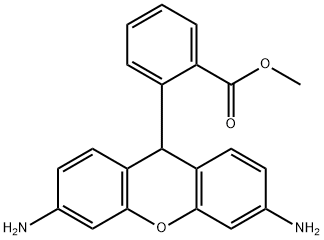DIHYDRORHODAMINE 123
Synonym(s):Dihydrorhodamine 123 - CAS 109244-58-8 - Calbiochem
- CAS NO.:109244-58-8
- Empirical Formula: C21H18N2O3
- Molecular Weight: 346.38
- MDL number: MFCD04221428
- SAFETY DATA SHEET (SDS)
- Update Date: 2024-11-19 23:02:33

What is DIHYDRORHODAMINE 123?
Description
DHR is a cell-
The Uses of DIHYDRORHODAMINE 123
Dihydrorhodamine 123 is the uncharged and nonfluorescent reduction product of the mitochondrion-selective dye rhodamine 123 used for investigation of reacitve oxygen intermediates.
The Uses of DIHYDRORHODAMINE 123
Dihydrorhodamine 123 (DHR) has been used for the detection of free intracellular radicals or ROS (reactive oxygen species) in head kidney-derived macrophages. It has also been used in DHR assay in red blood cells and in oxidative burst assay in neutrophils.
What are the applications of Application
Dihydrorhodamine 123 is a fluorescent probe commonly used for determination of peroxynitrite & other ROSs
General Description
Cell-permeable fluorogenic probe that is useful for the detection of reactive oxygen species (ROS) such as peroxide and peroxynitrite. Dihydrorhodamine is not fluorescent unless it is converted to rhodamine 123.
Biochem/physiol Actions
Cell permeable: yes
Properties of DIHYDRORHODAMINE 123
| Melting point: | 163–165℃ |
| Boiling point: | 526.9±50.0 °C(Predicted) |
| Density | 1.313±0.06 g/cm3(Predicted) |
| storage temp. | -20°C |
| solubility | DMSO: >5mg/mL |
| pka | 4.70 ± 0.40, most basic, temperature:
25 °C |
| form | powder |
| color | Light red or pinkish-white |
| λmax | 289 nm |
| BRN | 5989965 |
| Biological Applications | Generating,detecting & measuring reactive oxygen species; generating,detecting & measuring reactive nitrogen species; detecting phosphates,peroxynitrile; measuring respiratory burst; chronic granulomatous disease DHR assay; screening |
Safety information for DIHYDRORHODAMINE 123
Computed Descriptors for DIHYDRORHODAMINE 123
New Products
4-Aminotetrahydropyran-4-carbonitrile Hydrochloride (R)-3-Aminobutanenitrile Hydrochloride 4-AMINO-TETRAHYDRO-PYRAN-4-CARBOXYLIC ACID HCL 4-(Dimethylamino)tetrahydro-2H-pyran-4-carbonitrile 3-((Dimethylamino)methyl)-5-methylhexan-2-one oxalate 1,4-Dioxa-8-azaspiro[4.5]decane 5-Bromo-2-nitropyridine Nimesulide BP Aceclofenac IP/BP/EP Diclofenac Sodium IP/BP/EP/USP Mefenamic Acid IP/BP/EP/USP Ornidazole IP Diclofenac Potassium SODIUM AAS SOLUTION ZINC AAS SOLUTION BUFFER SOLUTION PH 10.0(BORATE) GOOCH CRUCIBLE SINTERED AQUANIL 5 BERYLLIUM AAS SOLUTION 2-Bromo-1-(bromomethyl)-3-chloro-5-nitrobenzene 2-Bromo-3-nitroaniline N-(3-Hydroxypropyl)-N-methylacetamide 3-Bromo-6-chloropyridazine 4-ethyl-3-nitrobenzoic acidRelated products of tetrahydrofuran








You may like
-
 Dihydrorhodamine 123 CAS 109244-58-8View Details
Dihydrorhodamine 123 CAS 109244-58-8View Details
109244-58-8 -
 Dihydrorhodamine 123 CAS 109244-58-8View Details
Dihydrorhodamine 123 CAS 109244-58-8View Details
109244-58-8 -
 1823368-42-8 98%View Details
1823368-42-8 98%View Details
1823368-42-8 -
 2-(3-(tert-butyl)phenoxy)-2-methylpropanoic acid 1307449-08-6 98%View Details
2-(3-(tert-butyl)phenoxy)-2-methylpropanoic acid 1307449-08-6 98%View Details
1307449-08-6 -
 Ethyl 3-(furan-2-yl)-3-hydroxypropanoate 25408-95-1 98%View Details
Ethyl 3-(furan-2-yl)-3-hydroxypropanoate 25408-95-1 98%View Details
25408-95-1 -
 2-Chloro-5-fluoro-1-methoxy-3-methylbenzene 98%View Details
2-Chloro-5-fluoro-1-methoxy-3-methylbenzene 98%View Details
1805639-70-6 -
 1784294-80-9 98%View Details
1784294-80-9 98%View Details
1784294-80-9 -
 Lithium ClavulanateView Details
Lithium ClavulanateView Details
61177-44-4